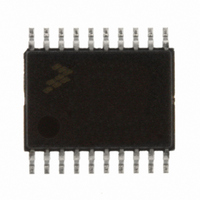MC9S08EL16CTJ Freescale Semiconductor, MC9S08EL16CTJ Datasheet - Page 205

MC9S08EL16CTJ
Manufacturer Part Number
MC9S08EL16CTJ
Description
MCU 16KB FLASH SLIC 20TSSOP
Manufacturer
Freescale Semiconductor
Series
HCS08r
Datasheet
1.DEMO9S08EL32.pdf
(356 pages)
Specifications of MC9S08EL16CTJ
Core Processor
HCS08
Core Size
8-Bit
Speed
40MHz
Connectivity
I²C, LIN, SCI, SPI
Peripherals
LVD, POR, PWM, WDT
Number Of I /o
16
Program Memory Size
16KB (16K x 8)
Program Memory Type
FLASH
Eeprom Size
512 x 8
Ram Size
1K x 8
Voltage - Supply (vcc/vdd)
2.7 V ~ 5.5 V
Data Converters
A/D 12x10b
Oscillator Type
External
Operating Temperature
-40°C ~ 85°C
Package / Case
20-TSSOP
Processor Series
S08EL
Core
HCS08
Data Bus Width
8 bit
Data Ram Size
1 KB
Interface Type
SCI, SPI, I2C, SLIC
Maximum Clock Frequency
200 KHz
Number Of Programmable I/os
16
Number Of Timers
2
Operating Supply Voltage
5.5 V
Maximum Operating Temperature
+ 85 C
Mounting Style
SMD/SMT
3rd Party Development Tools
EWS08
Development Tools By Supplier
DEMO9S08EL32AUTO, DEMO9S08EL32
Minimum Operating Temperature
- 40 C
On-chip Adc
10 bit, 12 Channel
For Use With
DEMO9S08EL32 - BOARD DEMO FOR 9S08 EL MCUDEMO9S08EL32AUTO - DEMO BOARD EL32 AUTO
Lead Free Status / RoHS Status
Lead free / RoHS Compliant
- Current page: 205 of 356
- Download datasheet (9Mb)
The SLIC clock is the same as the CPU bus clock. The module is designed to provide better than 1% bit
rate accuracy at the lowest value of the SLIC clock frequency and the accuracy improves as the SLIC clock
frequency is increased. For this reason, it is advantageous to choose the fastest SLIC clock which is still
within the acceptable operating range of the SLIC.Because the SLIC may be used with MCUs with internal
oscillators, the tolerance of the oscillator must be taken into account to ensure that SLIC clock frequency
does not exceed the bounds of the SLIC clock operating range. This is especially important if the user
wishes to use the oscillator untrimmed, where process variations might result in MCU frequency offsets
of ±25%.
The acceptable range of SLIC clock frequencies is 2 to 20 MHz to guarantee LIN operations with greater
than 1.5% accuracy across the 1–20 kbps range of LIN bit rates. The user must ensure that the fastest
possible SLIC clock frequency never exceeds 20 MHz or that the slowest possible SLIC clock never falls
below 2 MHz under worst case conditions. This would include, for example, oscillator frequency
variations due to untrimmed oscillator tolerance, temperature variation, or supply voltage variation.
To initialize the SLIC module into LIN operating mode, the user must perform the following steps prior
to needing to receive any LIN message traffic. These steps assume the MCU has been reset either by a
power-on reset (POR) or any other MCU reset mechanism.
The steps for SLIC Initialization for LIN operation are:
12.6.6.2
Bit rate synchronization is handled automatically in LIN mode, using the synchronization data contained
in each LIN message to derive the desired bit rate. In byte transfer mode (BTM = 1); however, the user
must set up the bit rate for communications using SLCBT.
More information on byte transfer mode is described in
including the performance parameters on recommended maximum speeds, bit time resolution, and
oscillator tolerance requirements.
After the desired settings of bit time are determined, the SLIC Initialization for BTM operation is virtually
identical to that of LIN operation.
The steps are:
Freescale Semiconductor
1. Write SLCC1 to clear INITREQ.
2. When INITACK = 0, write SLCC1 & SLCC2 with desired values for:
3. Write SLCC2 to set up prescalers for:
4. Enable the SLIC module by writing SLCC2:
5. Write SLCC1 to enable SLIC interrupts (if desired).
1. Write SLCC1 to clear INITREQ.
a) SLCWCM — Wait clock mode.
a) RXFP — Digital receive filter clock prescaler.
a) SLCE = 1 to place SLIC module into run mode.
b) BTM = 0 to disable byte transfer mode.
Byte Transfer Mode Initialization
MC9S08EL32 Series and MC9S08SL16 Series Data Sheet, Rev. 3
Section 12.6.16, “Byte Transfer Mode
Operation,”
207
Related parts for MC9S08EL16CTJ
Image
Part Number
Description
Manufacturer
Datasheet
Request
R
Part Number:
Description:
Manufacturer:
Freescale Semiconductor, Inc
Datasheet:
Part Number:
Description:
Manufacturer:
Freescale Semiconductor, Inc
Datasheet:
Part Number:
Description:
Manufacturer:
Freescale Semiconductor, Inc
Datasheet:
Part Number:
Description:
Manufacturer:
Freescale Semiconductor, Inc
Datasheet:
Part Number:
Description:
Manufacturer:
Freescale Semiconductor, Inc
Datasheet:
Part Number:
Description:
Manufacturer:
Freescale Semiconductor, Inc
Datasheet:
Part Number:
Description:
Manufacturer:
Freescale Semiconductor, Inc
Datasheet:
Part Number:
Description:
Manufacturer:
Freescale Semiconductor, Inc
Datasheet:
Part Number:
Description:
Manufacturer:
Freescale Semiconductor, Inc
Datasheet:
Part Number:
Description:
Manufacturer:
Freescale Semiconductor, Inc
Datasheet:
Part Number:
Description:
Manufacturer:
Freescale Semiconductor, Inc
Datasheet:
Part Number:
Description:
Manufacturer:
Freescale Semiconductor, Inc
Datasheet:
Part Number:
Description:
Manufacturer:
Freescale Semiconductor, Inc
Datasheet:
Part Number:
Description:
Manufacturer:
Freescale Semiconductor, Inc
Datasheet:
Part Number:
Description:
Manufacturer:
Freescale Semiconductor, Inc
Datasheet:










